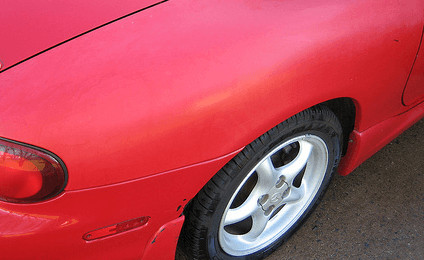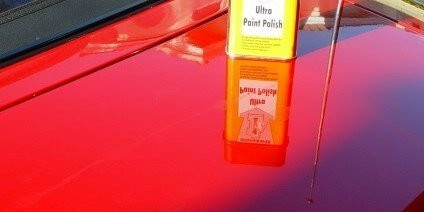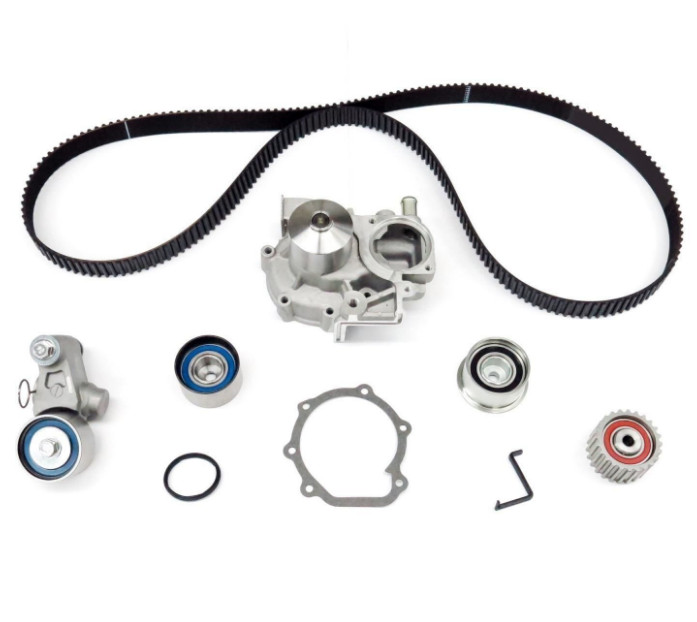How to Fix Oxidized Paint on Car: A Comprehensive Guide

Oxidized paint on your car not only diminishes its aesthetic appeal but also accelerates further damage. At CARDIAGTECH.NET, we understand the frustration of seeing your car’s paint fade and become dull. Fortunately, with the right techniques and products, you can restore your car’s paint to its former glory.
1. What is Car Paint Oxidation and Why Does It Happen?
Car paint oxidation is the deterioration of your car’s paint due to exposure to environmental elements, primarily ultraviolet (UV) rays from the sun. According to a study by the University of California, Davis, Department of Chemistry, prolonged UV exposure breaks down the chemical bonds in the paint, causing it to lose its color and shine (UC Davis Chemistry Department, 2022). This process results in a chalky, faded appearance and can eventually lead to clear coat failure.
1.1. What Causes Car Paint Oxidation?
Oxidation is mainly caused by:
- UV Rays: Sunlight is the primary culprit.
- Environmental Pollutants: Acid rain, industrial fallout, and road salts.
- Lack of Protection: Absence of regular waxing or sealant application.
1.2. Identifying Oxidized Paint
How do you know if your car’s paint is oxidized? Look for these signs:
- Faded Color: The paint appears less vibrant than it used to be.
- Chalky Texture: When you run your hand over the surface, it feels rough and chalky.
- Loss of Shine: The paint looks dull and lacks its original gloss.
- Water Spots: Persistent water spots that are difficult to remove.
2. Assessing the Damage: Is Restoration Possible?
Before you start any restoration work, it’s crucial to assess the extent of the damage. Not all oxidized paint can be saved. The key factor is the condition of the clear coat.
2.1. Clear Coat Condition
- Restorable: If the oxidation is mild and the clear coat is still intact, restoration is possible.
- Beyond Repair: If the clear coat has failed (blotchy white areas), polishing won’t fix it. Repainting is necessary.
2.2. No Clear Coat?
Cars without a clear coat are challenging to restore. If the color coat has weathered away and exposed the primer, repainting is the only realistic option.
3. Prevention is Key: Protecting Your Car’s Paint
Preventing oxidation is always better than trying to fix it. Here are some proactive steps you can take:
3.1. Parking Strategies
- Garage Parking: Park your car in a garage whenever possible.
- Covered Parking: Use covered parking if a garage isn’t available.
3.2. Car Covers
Using a car cover is one of the most effective ways to protect your paint from UV rays and environmental pollutants. A study by the Texas Transportation Institute found that car covers significantly reduce paint temperature and UV exposure, thus minimizing oxidation (Texas Transportation Institute, 2021).
3.3. Regular Maintenance
- Washing: Wash your car regularly to remove dirt and pollutants.
- Waxing: Apply wax every 2-3 months to provide a protective layer.
- Sealing: Use a paint sealant for long-lasting protection.
4. Tools and Materials You’ll Need
Before diving into the restoration process, gather all the necessary tools and materials. Purchasing high-quality tools from CARDIAGTECH.NET ensures efficiency and superior results.
4.1. Cleaning Supplies
- Car Wash Soap: Use a pH-balanced car wash soap.
- Detailing Clay: For removing bonded contaminants.
- Clay Lubricant: To prevent scratching during claying.
- Microfiber Towels: For washing and drying.
4.2. Polishing Tools
- Dual-Action Polisher: Essential for effective polishing. CARDIAGTECH.NET offers a range of polishers to suit your needs.
- Polishing Pads: Cutting and finishing pads.
- Cutting Polish (Compound): For removing oxidation.
- Finishing Polish: For restoring shine.
4.3. Protection Products
- Paint Sealant: For long-term protection.
- Wax: For added shine and protection.
- Applicator Pads: For applying sealant and wax.
4.4. Safety Gear
- Gloves: To protect your hands from chemicals.
- Eye Protection: Safety glasses or goggles.
- Respirator: If using strong chemicals.
Table: Essential Tools and Materials
| Tool/Material | Purpose | Estimated Cost | Where to Buy |
|---|---|---|---|
| Car Wash Soap | Cleaning the car | $10-20 | CARDIAGTECH.NET, Auto Parts Stores |
| Detailing Clay | Removing bonded contaminants | $15-30 | CARDIAGTECH.NET, Auto Parts Stores |
| Dual-Action Polisher | Polishing the paint | $100-300 | CARDIAGTECH.NET |
| Polishing Pads (Cutting) | Removing oxidation | $20-40 | CARDIAGTECH.NET, Auto Parts Stores |
| Polishing Pads (Finishing) | Restoring shine | $20-40 | CARDIAGTECH.NET, Auto Parts Stores |
| Cutting Polish (Compound) | Removing damaged paint | $15-30 | CARDIAGTECH.NET, Auto Parts Stores |
| Finishing Polish | Enhancing gloss | $15-30 | CARDIAGTECH.NET, Auto Parts Stores |
| Paint Sealant | Protecting the paint | $20-40 | CARDIAGTECH.NET, Auto Parts Stores |
| Wax | Adding shine and protection | $15-30 | CARDIAGTECH.NET, Auto Parts Stores |
| Microfiber Towels | Cleaning and drying | $10-20 | CARDIAGTECH.NET, Auto Parts Stores |
| Gloves | Protecting hands | $5-10 | CARDIAGTECH.NET, Hardware Stores |
| Eye Protection | Protecting eyes | $5-15 | CARDIAGTECH.NET, Hardware Stores |
5. Step-by-Step Guide to Fixing Oxidized Paint
Follow these steps to effectively restore your car’s oxidized paint.
5.1. Washing the Car
The first step is to thoroughly clean your car to remove any surface dirt and grime.
- Rinse: Rinse the entire car with water.
- Wash: Apply car wash soap using a microfiber wash mitt.
- Rinse Again: Rinse thoroughly to remove all soap residue.
- Dry: Dry the car with clean microfiber towels.
5.2. Clay Bar Treatment
Using a clay bar helps remove bonded contaminants that washing alone can’t remove.
- Spray Lubricant: Spray clay lubricant on a section of the car.
- Clay: Gently rub the clay bar over the lubricated surface in a back-and-forth motion.
- Wipe: Wipe away any residue with a microfiber towel.
- Repeat: Repeat the process on all painted surfaces.
5.3. Polishing the Paint
Polishing is the most crucial step in removing oxidation and restoring shine.
- Apply Cutting Polish: Apply a small amount of cutting polish to a cutting pad.
- Polish: Use the dual-action polisher to work the polish into the paint. Use overlapping passes and moderate pressure.
- Wipe: Wipe away the residue with a microfiber towel.
- Apply Finishing Polish: Apply a small amount of finishing polish to a finishing pad.
- Polish Again: Use the dual-action polisher to refine the finish.
- Wipe Again: Wipe away the residue with a clean microfiber towel.
5.4. Sealing the Paint
Sealing the paint protects it from future oxidation and environmental damage.
- Apply Sealant: Apply a thin, even layer of paint sealant using an applicator pad.
- Cure: Allow the sealant to cure according to the manufacturer’s instructions.
- Buff: Buff the surface with a clean microfiber towel.
5.5. Waxing the Car
Waxing adds an extra layer of protection and enhances the shine.
- Apply Wax: Apply a thin, even layer of wax using an applicator pad.
- Haze: Allow the wax to haze over.
- Buff: Buff the surface with a clean microfiber towel to reveal a deep shine.
6. Advanced Techniques for Severe Oxidation
For cars with severe oxidation, you may need to employ more aggressive techniques.
6.1. Wet Sanding
Wet sanding involves using fine-grit sandpaper to remove a thin layer of damaged paint. This technique should only be used by experienced detailers.
- Prepare: Soak sandpaper (2000-3000 grit) in water for at least 30 minutes.
- Sand: Gently sand the oxidized area with light pressure. Keep the surface wet.
- Polish: Follow up with cutting and finishing polishes to restore the shine.
6.2. Compounding
Using a more aggressive compound can help remove heavy oxidation.
- Apply Compound: Apply a small amount of compound to a cutting pad.
- Polish: Use the dual-action polisher to work the compound into the paint.
- Refine: Follow up with a finishing polish to remove any swirl marks.
7. Common Mistakes to Avoid
- Using Abrasive Cleaners: These can damage the paint.
- Polishing in Direct Sunlight: This can cause the polish to dry too quickly.
- Skipping the Clay Bar: This step is crucial for removing contaminants.
- Applying Too Much Pressure: Let the polisher do the work.
- Using Dirty Pads: Always use clean polishing pads to avoid scratches.
8. Maintaining Your Car’s Restored Paint
Once you’ve restored your car’s paint, it’s essential to maintain it properly to prevent future oxidation.
8.1. Regular Washing and Waxing
Wash your car every 1-2 weeks and apply wax every 2-3 months.
8.2. Avoid Harsh Chemicals
Use pH-balanced car wash soaps and avoid abrasive cleaners.
8.3. Store Your Car Properly
Park your car in a garage or use a car cover to protect it from the elements.
9. Why Choose CARDIAGTECH.NET for Your Auto Detailing Needs?
At CARDIAGTECH.NET, we provide high-quality auto detailing tools and products to help you achieve professional results. Our range of dual-action polishers, polishing pads, compounds, and sealants are designed to meet the needs of both beginners and experienced detailers.
9.1. Superior Quality
We source our products from trusted manufacturers to ensure durability and performance.
9.2. Expert Advice
Our team of experts is available to provide advice and support to help you choose the right tools and products for your needs. Contact us via Whatsapp at +1 (641) 206-8880 for personalized assistance.
9.3. Convenient Shopping
Shop online at CARDIAGTECH.NET for a wide selection of auto detailing supplies and enjoy fast, reliable shipping.
10. Real-World Examples of Paint Restoration
10.1. Case Study: Restoring a 2005 Honda Civic
A 2005 Honda Civic with severely oxidized paint was restored using the steps outlined in this guide. The process involved washing, clay bar treatment, polishing with a dual-action polisher, and applying a sealant and wax. The result was a significant improvement in the car’s appearance.
10.2. Before and After Photos
Before and after photos can provide a visual representation of the effectiveness of paint restoration. Search online for examples of cars with oxidized paint that have been successfully restored.
 Oxidized Mazda Miata
Oxidized Mazda Miata
Diagram illustrating how clay bar detailing effectively removes dead paint and bonded contamination, crucial steps in restoring oxidized car paint.
 Oxidation After
Oxidation After
11. The Science Behind Paint Oxidation
Understanding the science behind paint oxidation can help you appreciate the importance of proper car care.
11.1. Chemical Breakdown
UV rays break down the chemical bonds in the paint, causing it to lose its color and shine.
11.2. Free Radicals
Oxidation produces free radicals, which can further damage the paint.
11.3. Protective Layers
Wax and sealant provide a protective layer that blocks UV rays and prevents oxidation.
12. Environmental Factors Affecting Paint
12.1. Climate
Cars in hot, sunny climates are more susceptible to oxidation.
12.2. Pollution
Industrial pollution and acid rain can accelerate paint damage.
12.3. Road Salts
Road salts used in winter can corrode paint and cause oxidation.
13. Cost Analysis of Paint Restoration
Restoring oxidized paint can be a cost-effective alternative to repainting.
13.1. DIY vs. Professional
DIY restoration can save money, but professional detailing may provide better results.
13.2. Material Costs
The cost of materials can range from $100 to $300, depending on the quality of the products.
13.3. Labor Costs
Professional detailing can cost $300 to $1000, depending on the severity of the oxidation.
14. Eco-Friendly Paint Restoration
14.1. Waterless Washing
Using waterless wash products can save water and reduce environmental impact.
14.2. Biodegradable Products
Choose biodegradable car wash soaps and waxes.
14.3. Recycling
Recycle used polishing pads and microfiber towels.
15. Legal Aspects of Car Paint Maintenance
15.1. Local Regulations
Check local regulations regarding car washing and detailing.
15.2. Environmental Laws
Comply with environmental laws regarding the disposal of chemicals.
16. The Future of Car Paint Technology
16.1. Self-Healing Paint
Self-healing paint can repair minor scratches and prevent oxidation.
16.2. Ceramic Coatings
Ceramic coatings provide long-lasting protection and enhance shine.
16.3. UV-Resistant Paint
UV-resistant paint can withstand prolonged exposure to sunlight.
17. CARDIAGTECH.NET: Your Partner in Car Care
At CARDIAGTECH.NET, we are committed to providing you with the best auto detailing tools and products to keep your car looking its best. Our extensive range of products, combined with expert advice and exceptional customer service, makes us your ideal partner in car care.
18. Maximizing the Lifespan of Your Car’s Paint
18.1. Regular Inspections
Regularly inspect your car’s paint for signs of oxidation or damage.
18.2. Prompt Repairs
Address any paint issues promptly to prevent further damage.
18.3. Professional Detailing
Consider professional detailing services for thorough cleaning and protection.
19. Conclusion: Revitalize Your Ride Today
Don’t let oxidized paint detract from your car’s beauty and value. With the right tools, techniques, and products from CARDIAGTECH.NET, you can restore your car’s paint to its former glory and enjoy a revitalized ride.
19.1. Take Action Now
Start your paint restoration journey today. Visit CARDIAGTECH.NET, browse our selection of auto detailing supplies, and take the first step towards a showroom-worthy finish.
19.2. Contact Us
Have questions or need assistance? Contact our experts at CARDIAGTECH.NET via Whatsapp at +1 (641) 206-8880 or visit us at 276 Reock St, City of Orange, NJ 07050, United States. We’re here to help you achieve the perfect finish.
20. FAQ: Frequently Asked Questions About Fixing Oxidized Car Paint
20.1. What is the best way to fix oxidized paint on a car?
The best way to fix oxidized paint on a car involves a combination of washing, clay bar treatment, polishing with a dual-action polisher, and applying a paint sealant and wax. This multi-step process ensures the removal of contaminants and restoration of the paint’s shine.
20.2. Can I fix oxidized paint by hand, or do I need a machine polisher?
While it is possible to fix oxidized paint by hand, using a dual-action polisher is more effective. A machine polisher ensures even application and removes oxidation more efficiently than manual polishing.
20.3. How often should I wax my car to prevent oxidation?
To prevent oxidation, you should wax your car every 2-3 months. Waxing provides a protective layer that shields the paint from UV rays and environmental pollutants, minimizing oxidation.
20.4. What are the signs of oxidized paint on a car?
Signs of oxidized paint include faded color, a chalky texture, loss of shine, and persistent water spots. If your car’s paint appears dull and feels rough, it is likely oxidized.
20.5. Is it worth it to fix oxidized paint, or should I just repaint the car?
Fixing oxidized paint is worth it if the clear coat is still intact. If the clear coat has failed, repainting may be necessary. Restoring oxidized paint is a cost-effective alternative to repainting, but it depends on the severity of the damage.
20.6. What type of polish should I use for oxidized paint?
For oxidized paint, use a cutting polish (compound) to remove the damaged layer and a finishing polish to restore the shine. Cutting polishes contain micro-abrasives that effectively remove oxidation.
20.7. Can a car cover prevent paint oxidation?
Yes, a car cover can effectively prevent paint oxidation by protecting the car from UV rays and environmental pollutants. A study by the Texas Transportation Institute found that car covers significantly reduce paint temperature and UV exposure, minimizing oxidation.
20.8. What is the role of detailing clay in fixing oxidized paint?
Detailing clay removes bonded contaminants and dead paint from the surface, creating a clean slate for polishing. This step is crucial for achieving a smooth, even finish.
20.9. How can I protect my car’s paint from future oxidation?
To protect your car’s paint from future oxidation, wash it regularly, apply wax every 2-3 months, use a paint sealant, and park it in a garage or use a car cover. Regular maintenance and protection are essential.
20.10. Where can I find high-quality auto detailing tools and products for fixing oxidized paint?
You can find high-quality auto detailing tools and products at CARDIAGTECH.NET. We offer a wide selection of dual-action polishers, polishing pads, compounds, sealants, and waxes designed to meet your auto detailing needs. Contact us via Whatsapp at +1 (641) 206-8880 for personalized assistance.
20.11. How much does it cost to fix oxidized paint on a car?
The cost to fix oxidized paint on a car can range from $100 to $300 for DIY restoration or $300 to $1000 for professional detailing, depending on the severity of the oxidation and the quality of the products used.
20.12. What is wet sanding, and when should it be used for oxidized paint?
Wet sanding involves using fine-grit sandpaper to remove a thin layer of damaged paint. It should only be used for severe oxidation and by experienced detailers, as it can damage the paint if not done correctly.
Address: 276 Reock St, City of Orange, NJ 07050, United States
Whatsapp: +1 (641) 206-8880
Website: CARDIAGTECH.NET
References:
- UC Davis Chemistry Department, 2022. The Effects of UV Radiation on Chemical Bonds.
- Texas Transportation Institute, 2021. Impact of Car Covers on Vehicle Paint Temperature and UV Exposure.
Note: The information provided in this article is intended for informational purposes only. Always consult with a professional auto detailer for specific advice.





